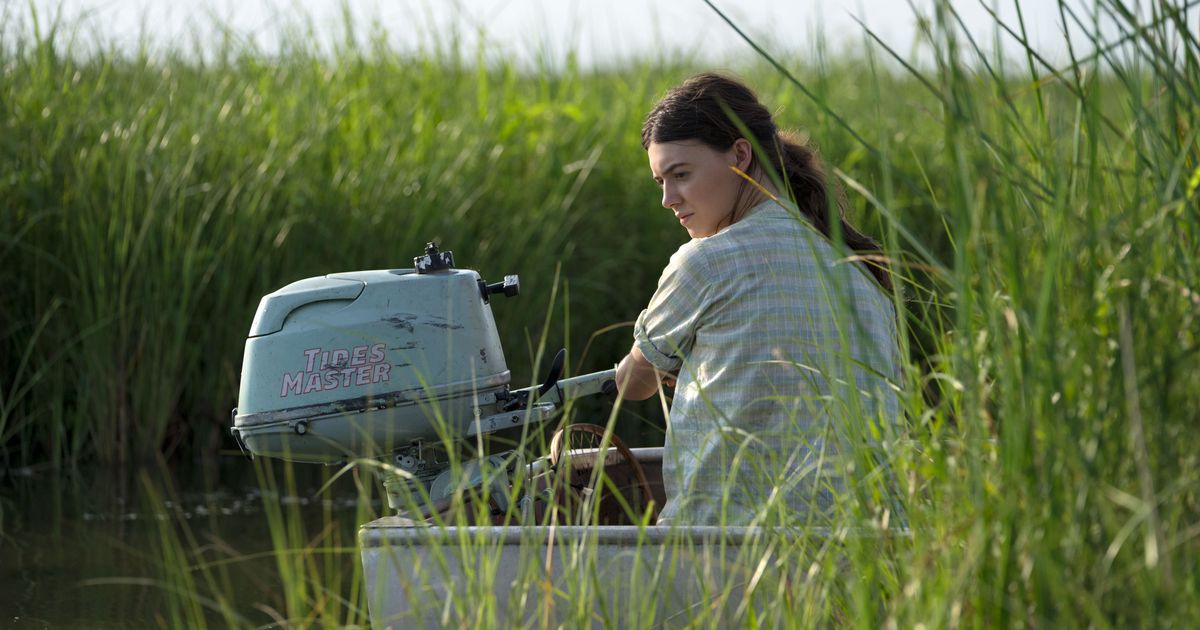
Where the Crawdads Sing Eats Itself into Nothingness
Bilge Ebiri is a film critic for New York magazine and Vulture. His work has appeared in The Village Voice, the New York Times, Rolling Stone, and the Criterion Collection, among others.
Daisy Edgar-Jones in Where the Crawdads Sing. Photo: Michele K Short
In a perfect vacuum, you probably wouldn’t guess that Where the Crawdads Sing is based on a runaway publishing phenomenon, a book that has sold more than 12 million copies in just a few years. One doesn’t have to have loved Delia Owens’s debut novel to see why it has appealed to countless readers. Part murder mystery, part swoony romance, part cornpone coming-of-age tale, it’s an atmospheric and gleefully overheated melodrama, the kind of book that might make you tear up even as you curse its (many, many) shortcomings. The movie is resolutely faithful to the incidents of the novel, but it doesn’t seem particularly interested in standing on its own, in being a movie. It feels like an illustration more than an adaptation.
The story of Kya Clark, a young girl abandoned by her destitute family and forced to survive on her own in a remote corner of the North Carolina wilderness, the film starts off (much like the book) with a murder investigation and then flashes back to her life. The body of a man, Chase Andrews (Harris Dickinson), has been found in the woods, and suspicion has settled on Kya (played as an adult by Daisy Edgar-Jones), a loner known to much of the town as “the Marsh Girl.” Taking up the case is a kindly local retired lawyer (played by a much-needed David Strathairn), who believes that Kya has been accused not because of any actual evidence against her, but because she’s been an outcast all her life, ridiculed and hated for years by the townsfolk as some kind of crazy, uncivilized brute.
As we go through Kya’s earlier years, we see a childhood defined by solitude — her mother and her siblings all leave their abusive father one by one, and dad himself (Garret Dillahunt) eventually disappears, leaving Kya alone in the family’s run-down shack on the edge of the marsh. As she grows up, Kya is romanced by a couple of blandly handsome two by fours — nerdy-nice Tate (played by Taylor John Smith as a grown-up) who shares her obsession with nature but then abandons her, and then local rich-boy Chase, who seems fascinated by her but clearly has little interest in a real relationship. We’re supposed to like one and dislike the other, but both Tate and Chase are so underdeveloped that it’s initially hard to feel much of anything for either. They barely register as people. Smith does little but stare lovingly, and Dickinson (who has, to be fair, distinguished himself in previous roles) brings a dash of snotty entitlement to Chase, but not much else.
The best thing about both novel and movie is Kya herself, a submerged character who finds solace and companionship in nature, and who, never having lived anything resembling a normal life around other people, doesn’t quite know what to do with her emotions. As the young Marsh Girl, Jojo Regina is quite moving; your heart goes out to her when a character reads out the local school lunch menu as a way of enticing the impoverished Kya to attend class. It’s a tough balance, to present a child as being both feisty and vulnerable without going overboard into schmaltzy pathos, and the film handles that particular challenge fairly well. As the grown-up Kya, Edgar-Jones is perhaps best at conveying this young woman’s wounded inner life; that speaks to the actress’s talents. However, she never really feels like someone who emerged from this world, but rather one who was dropped into it; that speaks to the clunky filmmaking.
It’s kind of a shock to find the movie version of Crawdads so lacking in atmosphere, as you’d think that’d be the one thing it would nail. Not the least because that lies at the heart of the book’s appeal: Owens spends pages describing the rough, wild, primeval world in which Kya lives, and she convincingly presents the girl as a part of the natural order of this untouched world. At various points, Kya sees herself reflected in the behavior of wild turkeys, snow geese, fireflies, seagulls, and more. She calls herself a seashell and later on finds friendship in Sunday Justice, the jailhouse cat. Where the Crawdads Sing is a book that drips with atmosphere and environmental detail, which enhance our understanding of the protagonist — and help justify some of the story’s more dramatic turns. Owens is herself a retired wildlife biologist who had previously written a number of nature books before turning to fiction. It’s no surprise that her novel works best as an extension of her prior work.
By contrast, the film’s director, Olivia Newman, presents the marsh as a postcard-pretty backdrop, a mostly distant and at times surprisingly calm and orderly space. There’s little sense of wildness, of unpredictability or abandon. Readers will of course often imagine settings differently than film adaptations, but that’s not the problem here. Onscreen, the marsh just never really registers as any kind of place, and it certainly doesn’t register as a spiritual canvas for Kya’s journey. (At times, I wondered if some of the landscape shots might actually have been green-screened in.) Even the fact that Kya has spent much of her life drawing the wildlife of the region – which ultimately plays a huge role in who she becomes – doesn’t come into play until relatively late in the film. None of these would necessarily be problems if the film weren’t otherwise so faithful to the book’s narrative.
This is the challenge of literary condensation. The murder investigation and the ensuing courtroom drama are the least compelling parts of Owens’s novel, there mostly as a loose framing device to tell Kya’s life story. Indeed, she saves the bulk of the trial for the back half of the book, and then breezes by the suspense and the procedural back-and-forth, presumably because she’s not interested in all that. (Spoiler alert: She’s more interested in the twist she springs in her final pages – a twist that also has some eerie echoes of a real-life murder investigation in Zambia that Owens and her ex-husband are reportedly embroiled in, but that’s a whole other crazy story.)
That leaves the movie with a genre-friendly structure, but almost nothing to populate it with. As a result, for much of Where the Crawdads Sing, we’re left watching a not-very interesting and all-but predetermined trial, with little suspense or surprise. We don’t ever really see what the prosecution’s case is against Kya. (If you read the book, you’d have some sense of it, but even there, it’s cursory and half-baked.) It’s a classic Catch-22: The film, to stay true to its wildly popular source material, has to focus on the case, which in turn leaves the picture little room to breathe, to let the audience bask in the atmosphere of this fascinating milieu… which is at least partly why the source material was so wildly popular in the first place. So, forget the crawdads, the turkeys, the fireflies, the seashells, and the snow geese. Forget even the jailhouse cat. The movie is a snake that eats itself.









![[VIDEO] Gelagat Che Ta Tunggu Aaisyah Bersiap Cetus Perhatian Ramai!-“Tengok Penampilan, Tercampaklah Mak Hang!” [VIDEO] Gelagat Che Ta Tunggu Aaisyah Bersiap Cetus Perhatian Ramai!-“Tengok Penampilan, Tercampaklah Mak Hang!”](https://i0.wp.com/murai.my/wp-content/uploads/2024/04/25DCA8CF-C629-4DCA-8597-2CA8819D9297.jpg?resize=150%2C150&ssl=1)














![[VIDEO] Reaksi Tunku Azizah Sambut Birthday Anakanda Tengku Puteri Jihan, Raih Perhatian Ramai! [VIDEO] Reaksi Tunku Azizah Sambut Birthday Anakanda Tengku Puteri Jihan, Raih Perhatian Ramai!](https://i0.wp.com/murai.my/wp-content/uploads/2024/04/Untitled-design-27.jpg?fit=300%2C300&ssl=1)










![[VIDEO] Nadhir Nasar Sambut Birthday Tengku Ameera Cetus Perhatian Ramai”- Nak Kena Bersaing Dengan Kerabat Pulak, Hmm” [VIDEO] Nadhir Nasar Sambut Birthday Tengku Ameera Cetus Perhatian Ramai”- Nak Kena Bersaing Dengan Kerabat Pulak, Hmm”](https://i0.wp.com/murai.my/wp-content/uploads/2024/04/D3415DF6-2464-4794-880F-841EB898C969.jpg?w=768&ssl=1)































